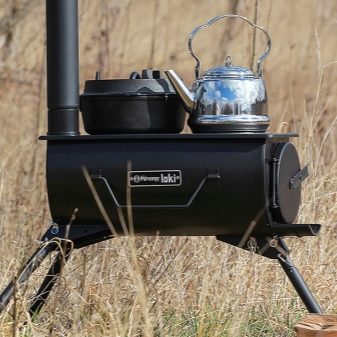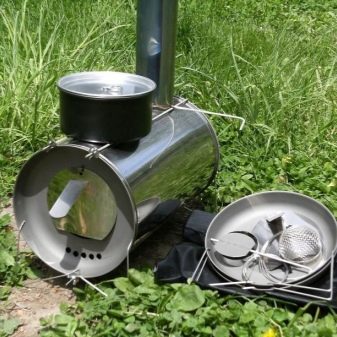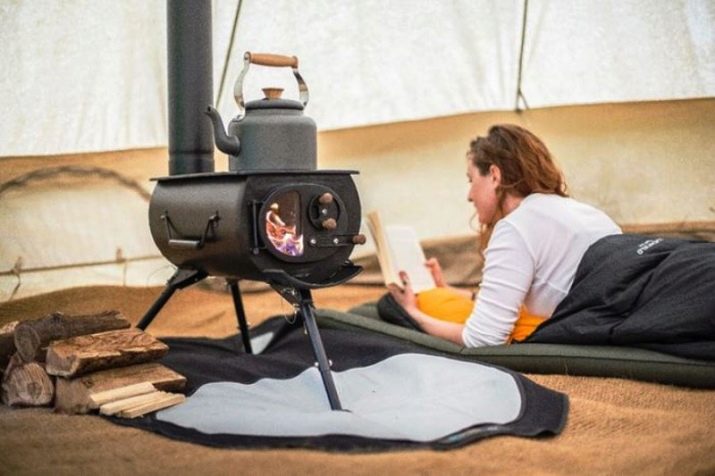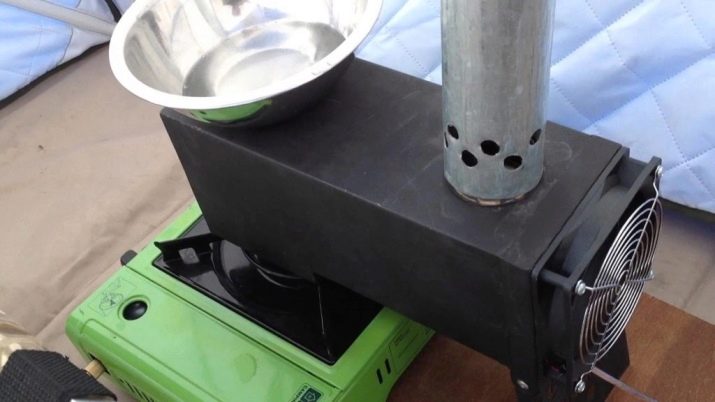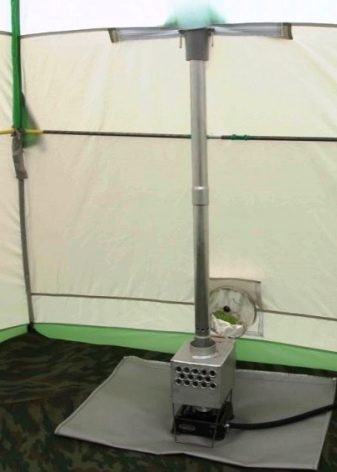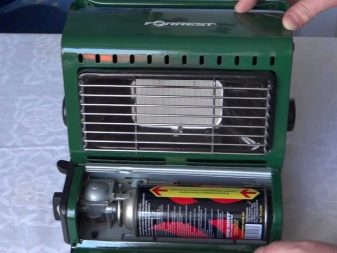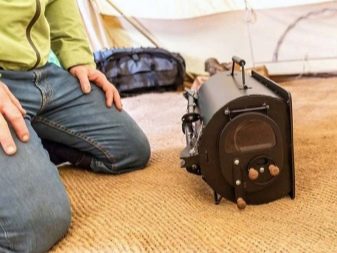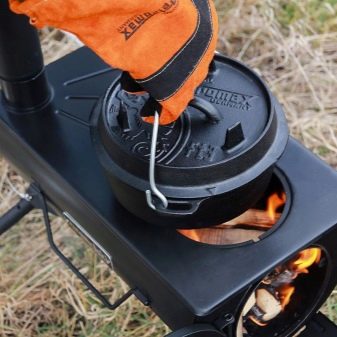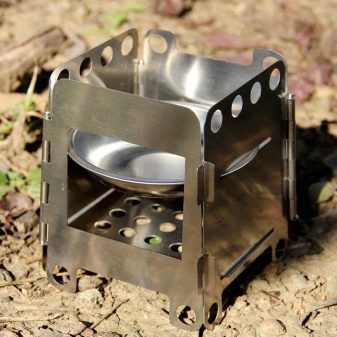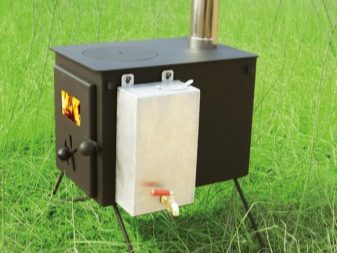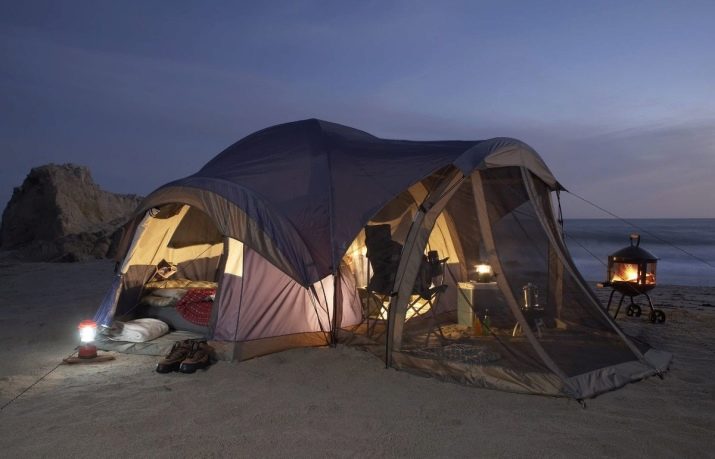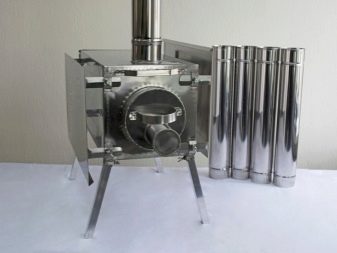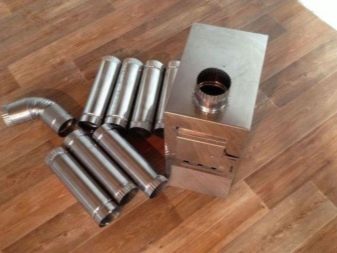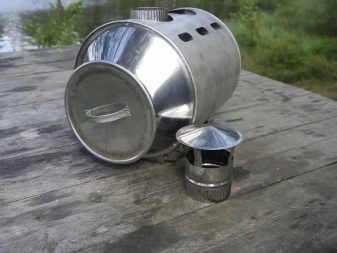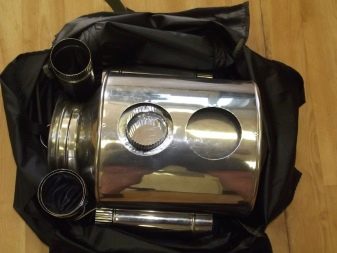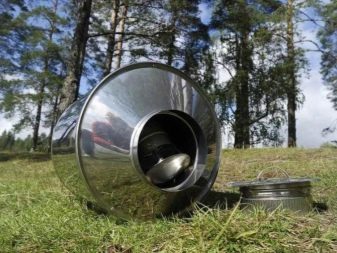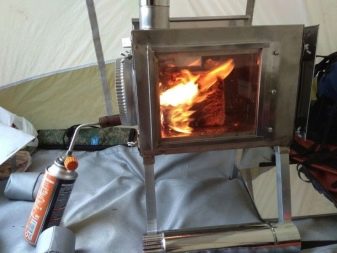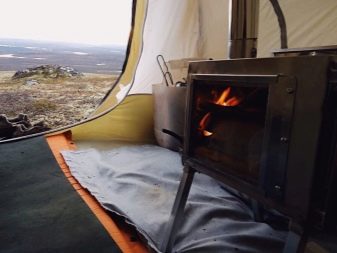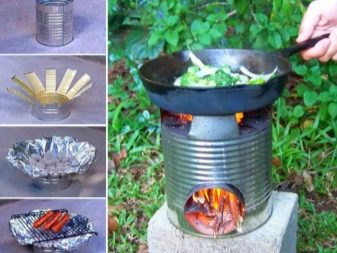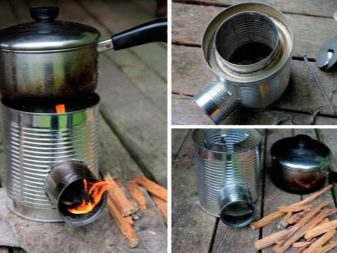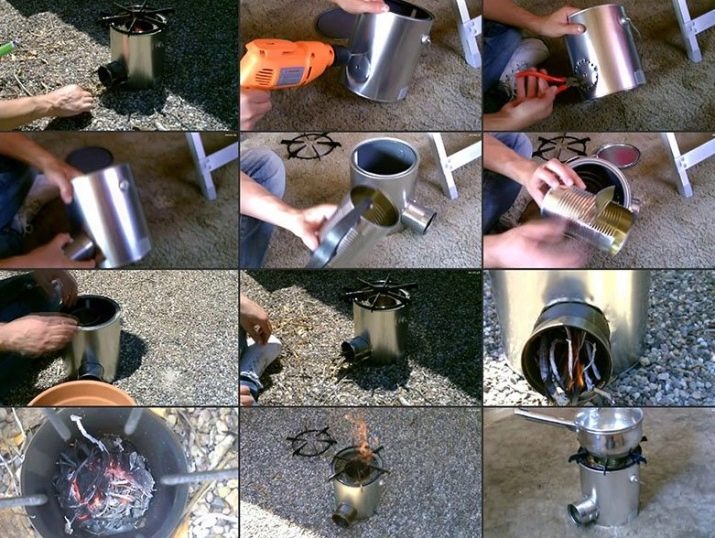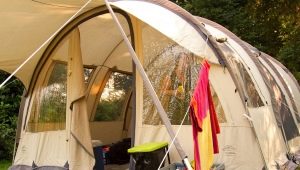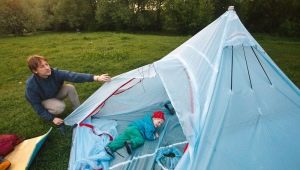Tent stoves: description, variations and selection
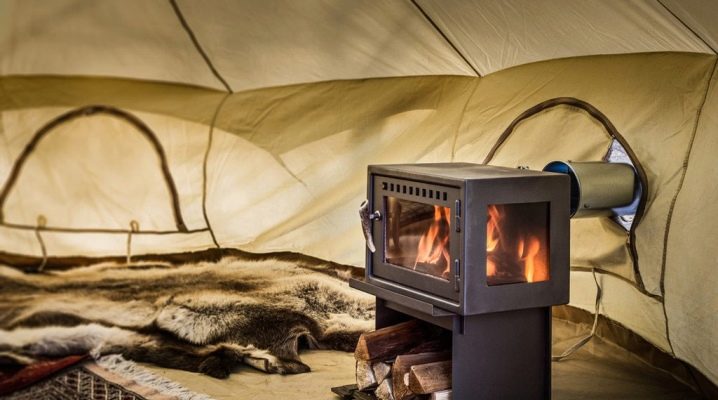
During long hikes and expeditions during the cold season, travelers cannot do without a heat source in the tent, as well as fishermen in winter fishing. In order to have a good rest at night, the tent furnace will be the easiest and most effective means. Consider the main types of devices, its differences and range of application.
Features
The device is intended not only for heating an overnight stay. It can also be used as a tile for cooking and boiling a kettle. And there is also the possibility of drying soaked clothes and shoes in the immediate vicinity of the furnace. But leaving shoes or clothes on the stove surface can lead not only to their deterioration, but also to a fire in the tent. When choosing a unit, you need to rely not only on the brand name of the manufacturer, but also on the material of which the stove and chimney is made, the diameter and direction of the pipe.
Such a device has a number of advantages:
- relatively small size, which attracts most buyers;
- good tent heating result;
- a light weight;
- ideal for use in both winter and in an ordinary camping tent.
No matter how good this acquisition may be, it will always have flaws with which not everyone will be easy to accept.
- High cost. Not every traveler will afford such equipment.
- Size can be both an indisputable advantage and a significant disadvantage. for a particular hike, if it runs through dense forests or rocky terrain. This only applies to species that cannot be disassembled.
It is important to consider the material and purpose of the tent itself. As a rule, winter tents are provided for use in them of heating accessories, in their production more dense materials are used. And also similar types of tents have a double layer of walls, which does not allow too much heat loss, which is not the case with the usual summer hiking tent. If there is a need to use heating in it, then it is imperative to take some precautions.
For example, find out the characteristics of this tent and make sure that the material of the simple model can withstand high temperature, as well as install the stove itself away from the tent walls.
Kinds
Although outwardly all the furnaces are very similar, they have a lot of differences: according to the principle of operation, design and method of installation in the tent itself. All devices differ in wood and gas.
Wood burning stove is the most common type. Its main advantage is the almost endless supply of fuel. While the gas will work until the gas in the cylinder runs out, which will not be difficult to bring with you. This heating option will be relatively inexpensive, most importantly, safe to use.
This indispensable thing will suit the fishermen in the winter, as it will be much easier to bring a gas cylinder with you than to carry a bundle of firewood behind you.
Probably the most recognizable stove - "Stove". For dozens of years of its existence, has undergone hundreds of modifications, but the principle of operation has not changed. It does not have a specific geometry, it can be round or square, it has a good heat transfer. This option is very popular with fans to do everything with their own hands. The stove is characterized by low costs and a good result at the output.
For lovers of hiking are well suited collapsible mini-ovens. They are lightweight, disassembled take up very little space.In terms of their functionality, they are in no way inferior to their “adult” brethren, with the exception of one problem inherent in all collapsible stoves: having no stiffening ribs, they are strongly curved due to temperature. As a rule, collapsible stoves are relatively inexpensive. Price depends on the material used in the assembly process.
The better the material is resistant to high temperatures, the higher the cost.
When it comes to large tents for 10 people, as well as heating of small areas, such as a storage room, basement, and the like, the stove should correspond to the volumes. For such needs, suitable portable stove. She is often chosen by summer residents, geologists and rescuers. This choice is due to the relatively small size and weight of the furnace, its efficiency, reliability and efficiency.
Such a device is easy to move from place to place, it does not require a lot of fuel, it is easy to install and will not interfere with other things.
The furnace manufacturing process uses materials such as cast iron and titanium. Cast iron and titanium devices are more reliable, but rather heavy. Models made from these metals are durable and resistant to high temperatures, but are quite rare.
When searching for the perfect stove for a tent, you need to understand that there is no one universal model for all life situations. Each option is designed for some specific purposes.
Popular models
On sale there are many options for every taste, color and wallet. Let us examine the most common species, which are preferred by most lovers of hiking holidays.
Perhaps the most desirable stove in each tent - housekeeper. Not only for their ability to quickly warm the tent, but also for the beautiful appearance that adorns the interior of any shelter. Consider the features of this stove for example products firms "Bereg". The main advantage of this device is its compactness and light weight in production food heat resisting stainless steel is applied.
The material is resistant to high temperatures and does not corrode. Even small deformations during transportation will not degrade the characteristics of the furnace. The presence and possibility of installing and dismantling the protective screens, if necessary, can add security when leaving it unattended for a short period of time.
The stove has a removable cup on the fan, which allows it to be used in the mode of long burning for 5 hours on one tab of firewood. This will eliminate the need to constantly monitor the fire and throw firewood. Removable aluminum legs are attached to the case with screws in the shape of a lamb. It provides good stability and quick assembly.
Disassembled device has a compact size and carrying bag. Many other models have a significant drawback in the form of separately portable parts of the chimney. In the same instance, this problem is solved by folding the collapsible chimney inside the firebox, saving space.
The second no less useful, popular stove model - "Tourist Gorynych." Such a device has a round body made of high-strength, heat-resistant stainless steel, resistant to deformation from high temperatures. End parts in the form of cones, which gives more rigidity to the structure. The inside of the ends is supplemented with stone wool for improved thermal insulation.
This ensures that the furnace heats up the right heat sink in the right places, and also protects the awning and your hands from accidental burns.
To improve convection, increase thermal efficiency and safety properties, the models of Gorynych ovens are equipped with protective casing. This element is a very important and useful part of the device.
Tourist stove "Gorynych", working from firewood, can be converted to other types of fuel.One of the features of the device is the possibility of additional installation of a gas or diesel module. These elements are capable of making the furnace a multi-fuel field-expedition heater that has many useful functions.
One of the main criteria for choosing a furnace is fire safety. In this instance, a great deal has been done for this purpose. This unit has 2-tier sparking system (a chipper in the inner part of the furnace itself and an umbrella catcher on the pipe). In addition, the chimney is equipped with an additional spark arrestor, which does not allow sparks to fly out.
Protection from accidental ignition of grass or the floor of the tent will be ensured by high legs and a convenient box for ash waste, and design features make it possible to avoid excessive heating of chimney pipes. Auxiliary protection of the owner and the material of the tent is provided by the "cold" execution of the front and rear walls of the furnace, as well as the protective casing.
In addition to well-known brands and models, you can also see budget stoves on counters. As a rule, they are made in the image and likeness of well-known brands with small differences, for example, as the used metal. Such a stove is more susceptible to deformation due to temperature - the thinner the “black” metal used in production, the shorter the service life of the device.
Otherwise, these stoves will work the same way as usual with wood. With all the disadvantages of cheap models, they have one very significant plus, often outweighing even good models from well-known manufacturers - this is the price. Such options are very cheap compared to those described above.
How to choose?
If there is a huge variety of options on the market for all occasions and for any budget, the main question remains: what model to buy. It all depends on:
- in what conditions will be used;
- for what terrain you have to use it;
- what is the size of the heated area.
Virtually every model on the market is designed for specific operating conditions.
For example, on a foot expedition through the taiga it is not advisable to purchase an option on gas fuel, as it is illogical to heat gas in the forest, and even carrying a small gas bottle on yourself is not very pleasant. Or a fisherman, going fishing in the winter, being on the ice (in the middle of a river or a lake), will not be so comfortable running around to the next forest for firewood. That is, it is easier and cheaper to operate a gas stove for a fishing tent, and a wood model would be appropriate for an expedition in a forest.
Having decided on the conditions in which to use this device, you should pay attention to the material from which it is made. The quality of raw materials directly determines how safe the purchase will be.. It must be performed from quality materials, without visible defects, indicating a fake. It is advisable to buy such things in specialized stores that can give a guarantee on the goods.
Operating rules
To install a stove in a tent, you will need to prepare a place for a particular model. It all depends on its design and installation method. When choosing it, you can not forget about safety. It is forbidden to install the stove too close to the walls of the tent. According to the instructions, we collect the firebox and stand, if they are disassembled. Next, proceed to the assembly of the chimney also follow the instructions.
Pipes should be tightly connected to each other. with a little effort until it stops in the flared part. After final assembly, you can proceed to check for tightness. To do this, you need to make a small fire in the firebox to see if there is a smoke leak. If found, it must be eliminated.
It is impossible to completely heat the furnace after assembly without checking. After a trial run, you can start heating the shelter.
How to do it yourself?
The process of making the furnace itself is relatively simple. You will need at least a finished drawing in order to know how much and what size parts will be needed. Enough and the initial skills of the welding craft (if you expect welds). And it can also be a collapsible version, completely cut from sheet metal. Then welding will not be necessary. But not every product will require such a quantity of material and time.
It is possible to make a small stove even out of the garbage that lies in the garage, namely, from one mug of metal and a certain number of cans.
You will need the following components:
- cans left over from canned food (height 6 cm, diameter 10 cm) - 2 pcs .;
- 1 piece of metal mug (diameter, 1 cm smaller than cans);
- bolts;
- washers;
- TV antenna;
- terminal (suitable from the old power supply).
Putting it all together.
- Existing irregularities and sharp edges of the cans must be leveled. For this you can use pliers.
- Cut out from tin round detail with a diameter of 3 cm with three petals. We bend the last at an angle of 90 degrees. In the bottom of the jar holes are made of a suitable size so that the tips of the petals are placed in them.
- The circle must be placed under the bottom of the banks. Petals fix in the holes. The resulting compartment will perform the function of the furnace.
- We retreat from the top of the jar 2 cm and make three holes of 5 mm in the same distance from each other. We put in them the bolts, reinforcing washers.
- Mug should be fixed on the bolts.
- We make 3 legs from the antenna. It will be necessary to make new holes to which they will be attached.
- We make a cover from the second can. It should be firmly and firmly attached to the top of the stove to save more heat. The handle from the terminal is allowed to be placed in the central part of the cover.
- On the bottom of the resulting furnace you will need to prepare 5-6 holes at the same distance from each other.
How to choose stoves for tents, see the following video.
